The Ultimate Guide on How to Measure Bra Size at Home and Look Like a Goddess
“Forty pictures I was in, and all I remember is 'What kind of bra
will you be wearing today, honey?' That was always the area of big
decision - from the neck to the navel.”
Donna Reed
What is the main purpose of a bra? Seduction? Support? Looking feminine? Keeping everything in place while exercising? The thing is – a well-fitted bra is all of the above and much more! A bra that fits perfectly together with a well-defined waistline is a key to exceptional tenure, so you should take time doing your bra size measurement to make sure the piece you wear flatters your look and compliments your body.
Too loose, overly tight and ill-fitting bra will not only hurt your posture, it might also damage your breast tissue, cause sagging breasts and even spine deformations. Besides having the right size, a lady should also know what a good bra should feel like and what model is appropriate to wear at what occasion.
Three steps to finding a perfect bra:
- Know your size
- Know a good bra when you try it on
- Know how to wear a bra properly
Genie Bra Size Chart: Measure Like a Madwoman
When Math comes first, Sexiness comes right after
Even if you already know what size to look for when shopping in the underwear sections, it’s never too late to get a professional advise on how to define your size. All the bra measurements must be done when wearing simple underwear that doesn’t modify your natural shapes or volume. It might be a good idea to check out bra fitting guide first to understand that you are starting off with a proper brassiere.
Once you’ve determined that the bra you are wearing now doesn’t distort your natural shape, you need to determine two main values that will lead you to a right bra size.
The Band – the Queen of the Bra
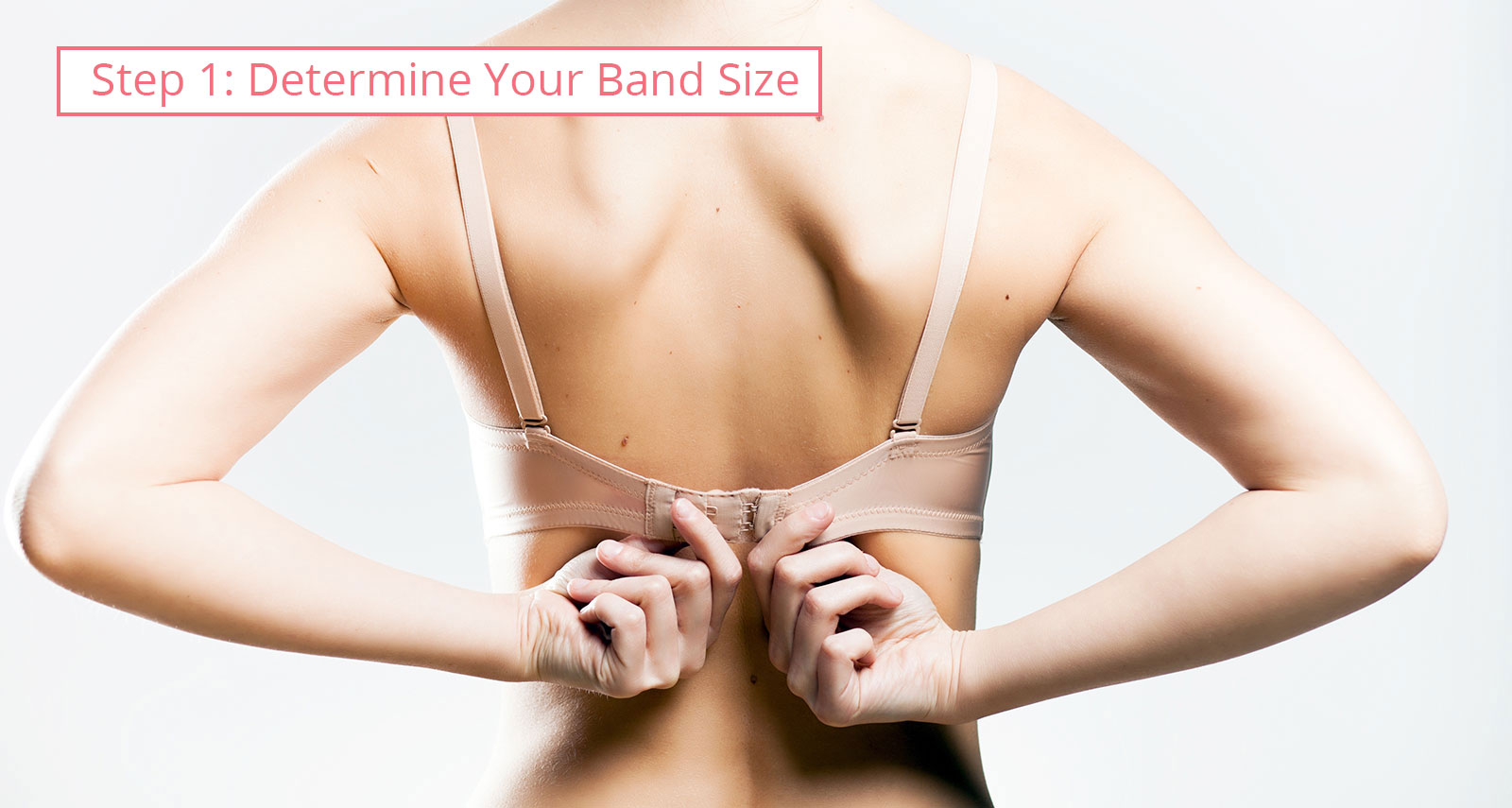
The first number you need to define is the band size. The band is one of the most important parts of your bra in terms of support, so don’t neglect it. There are two ways to measure it, and we suggest you do both and make sure the results match:
- Wrap a measuring tape around your rib cage, just below your bust line. Make sure your breasts are virtually “sitting” on the tape. (Line 1 on the pictures below);
- Wrap a tape a little higher now – under your arms and above the bust line, where your upper breast connects with a collarbone
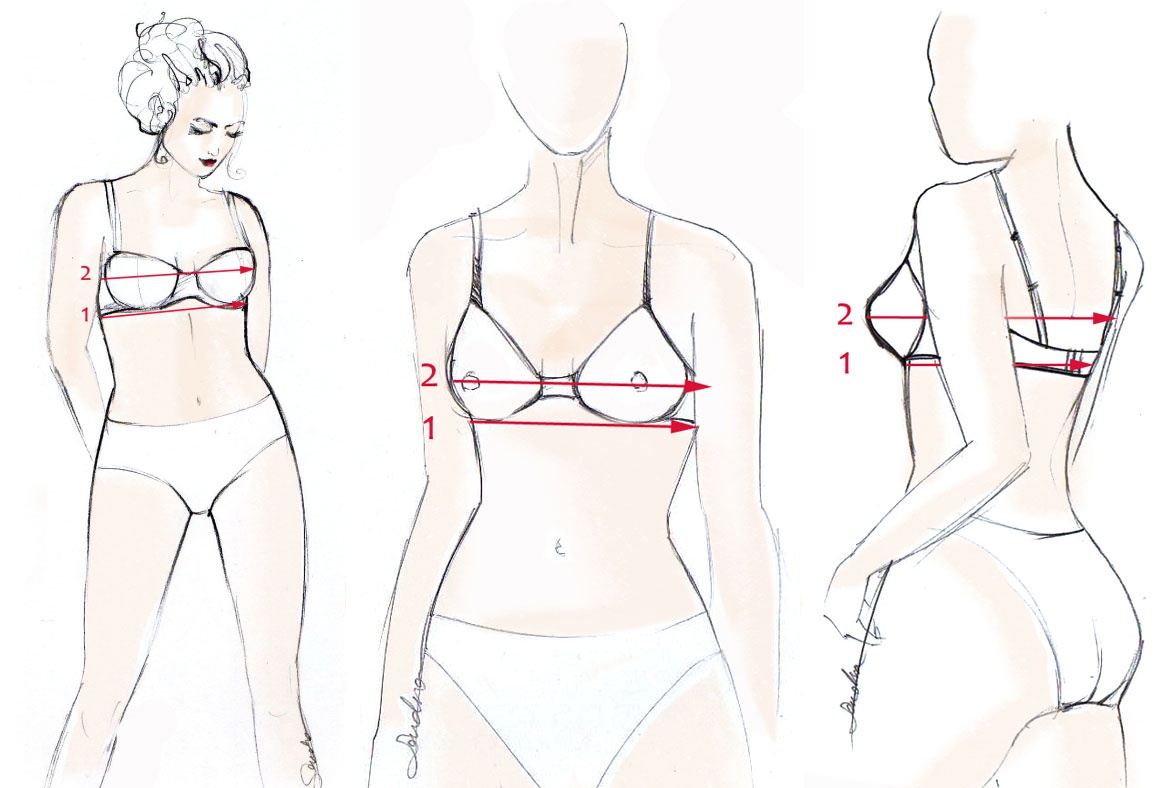
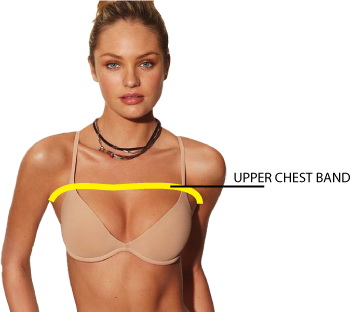
NB!
- Keep the measuring tape in a nice even line around your chest, just like the band should be;
Make sure the both numbers match with a 10-15% margin of error. Now it’s time to do the math!
The basic bra measurement chart will simply require 2 steps:
- Round up the value to the nearest whole number (optional, the chart below also includes decimal numbers);
- Add 4 to every even number to get a band size;
- Add 5 to every odd number to get a band size.
Sometimes you will see a more complicated scheme. For example, Victoria Secret bra size chart will require 4 steps:
- Round up your result to the closest even number (or if you don’t do it, then add +1” in the next calculations);
- Add 4 to every number that is smaller or equals 30”;
- Add 2 to every number that is from 32” to 36”;
- Add 0 to every number that is 38” or more.
In order to define your basic bra size, we suggest you follow the first “Plus 4 or 5 rule” and then later adjust the model fit by finding sister sizes, which we will show below.
For Example:
31.2” Your Chest Measurement = 32”(round up to the closest whole number) = 36 Band Size
| Bust Line (inch) | 24 ≤ 26.8 | 26.9 ≤ 28.8 | 28.9 ≤ 30.8 | 30.9 ≤ 32.8 | 32.9 ≤ 34.8 | 34.9 ≤ 36 |
|---|---|---|---|---|---|---|
| Band Size | 30 | 32 | 34 | 36 | 38 | 40 |
Why do you round up 30.8 to 30, when 31 is closer? Don’t forget that unlike the tape measure, the band is made of elastic materials that will give in when you breathe. So always round up to the smallest number when possible or exhale while measuring.
Signs that you're wearing the wrong band size:
- The band slides about and rides up at the back. The band of the bra should be horizontal all the way round and quite a snug fit. If you pull the shoulder straps upwards, the band should grip your back. If it slides up easily, or if your boobs pop out under the bottom of the bra, the band is probably two or more sizes too big.
- You're always having to pull the back of the bra down. This could be a sign that it is riding up and you need a tighter band.
- The band feels roomy and you can easily fasten the hooks on the smallest adjustment, even when brand new. The band of your bra needs to be a snug fit in order to support the cups, and it should fit on the biggest adjustment so that you are able to tighten it when the elastic starts to wear out. If it fits firmly against your body, but you have to fasten it on the tightest adjustment straight away, it's probably one size too big (see the centre image below.)
- You can stretch the back of your bra away from your body by several inches. You should be able to run a couple of fingers around inside the band to make sure it is not cutting in, but if you can fit more than a fist under the back, it's too loose.
This simple test should help you to determine if the band size of your bra fits properly, and if not, what you need to change.
-
There are usually 3 sets of eyes on which to fasten the hooks of the bra. Start by fastening your bra on the loosest setting and run two fingers around under the edge of the band. How does it feel?
- a) Very tight. the edges of the band cut in painfully.
- b) Snug. The bra does not move when I twist around, but it doesn't cut in either.
- c) Comfortable, roomy, not very tight.
- d) Loose. The elastic is hardly under any tension.
-
With the bra still on the loosest adjustment, take hold of the front of the bra by the band, and pull it outwards from your chest.
- a) I can barely get my fingers under the band.
- b) I can only pull it out by an inch or so.
- c) I can pull it out by a couple of inches or more.
- d) I can stretch the bra out from my chest by several inches.
-
Now take hold of the back of the bra, and pull it away from your body. Try to fit the width of your fist under the band. (Refer to the image on the first page.)
- a) I can only pull it away from my back by an inch or so.
- b) I can just fit a fist under the band, but no more.
- c) I can pull it out by four to six inches.
- d) I can stretch the bra away from my back by more than six inches.
-
Stand side-on next to a mirror so you can see your back. With the bra still fastened on the largest adjustment, raise your arms and take a look at the band. Is it horizontal all the way around, or is it higher at the back?
- a) The band is horizontal all the way around or slightly lower at the back, and it grips my body uncomfortably when I move.
- b) The band is horizontal all the way around or slightly lower at the back, but doesn't dig in.
- c) The back of the bra rises up slightly in the middle forming an arch, and it's a bit higher than the front.
- d) The back of the bra forms a distinct arch and is noticably higher than the front. It may feel as though your breasts are going to fall out under the band.
-
Now fasten your bra on the tightest set of eyes. How does it feel now?
- a) I can't fasten it on the tightest setting.
- b) Very tight. Too tight to be comfortable.
- c) A more snug fit.
- d) No noticable difference.
Answers:
- Mostly a: The band of your bra is probably too small. Try one size larger.
- Mostly b: It looks like you're wearing the correct band size.
- Mostly c: Your band size is too big. Try one size smaller.
- Mostly d: Your band size is too big. Try two or more sizes smaller.
The Cups – the Lair of the Brassiere
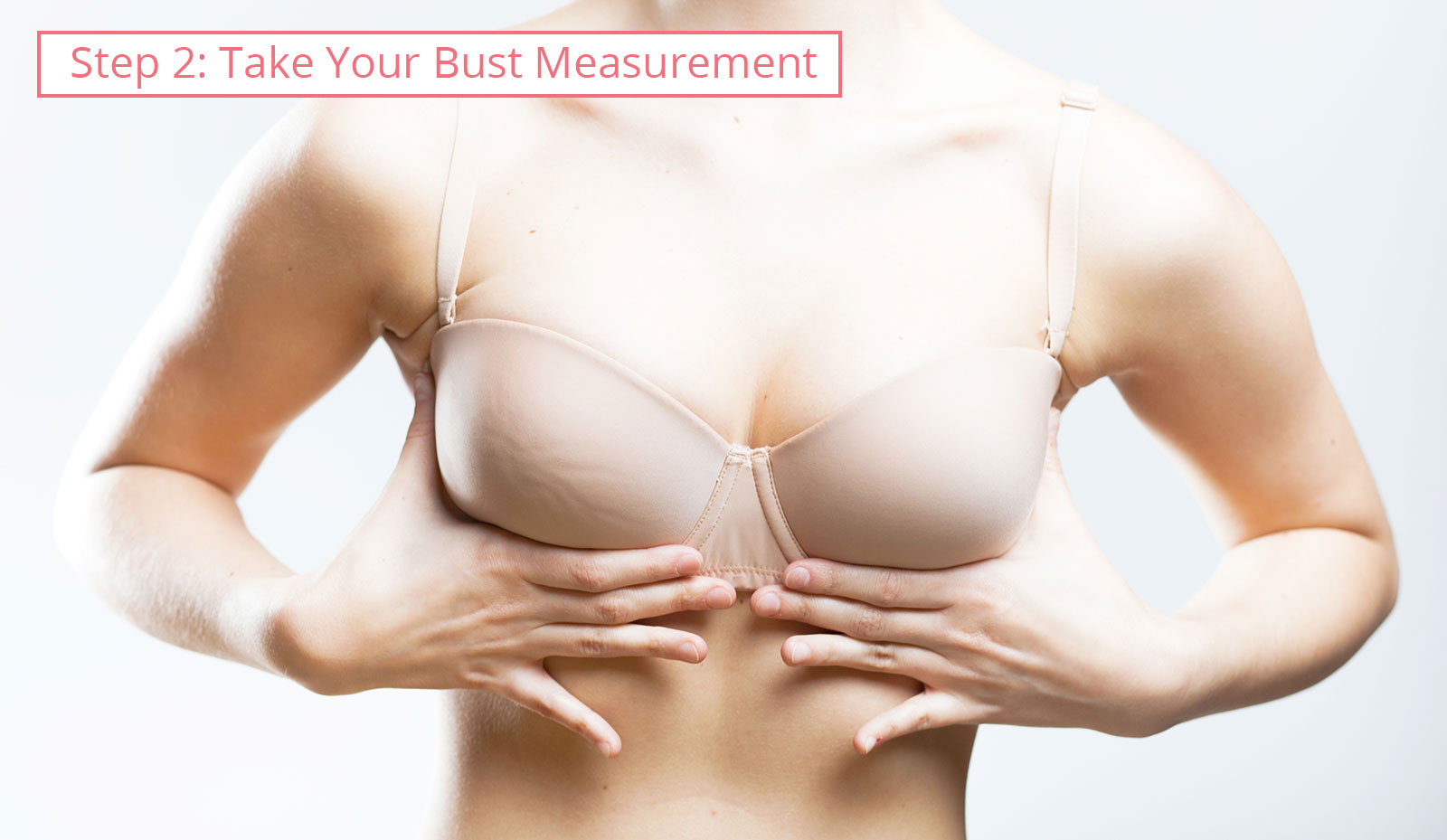
Now let’s assess the most generous part of your curves. Again, you will do it in two ways to make sure the value you use represents your breasts in the most accurate way.
- Wrap the meter around the middle part of your breasts, on the same level as your nipples; keep it even and tight against your back, but not squeezing the breasts tissue;
- Bend down, your back parallel to the ground and measure again your fullest bust line. This is necessary to take into account big breasts. If this second number if greater than the first one by over 2”, then use it in all your further math manipulations. If the difference between the value you get while standing up and leaning over is less than 2” – use the first number.
Let’s do little more math now:
- Round the amount you get to the nearest whole number.
- Subtract the band number from the breast measurement to get the cup size.
Bust - Band = CUP
For example:
34 – 36 = 2 = B
37 – 34 = 3 = C
| Value=Bust-Band (inches) | <1" | 1" | 2" | 3" | 4" | 5" | 6" |
|---|---|---|---|---|---|---|---|
| Your Cup Size | AA | A | B | C | D | DD | DDD (E) |
Signs that you're wearing the wrong cup size:
- The top edge of the cups make a double bulge. The cups should make a smooth profile, even in push-up styles. If you are spilling out, even a small amount, try a bigger cup size.
- The underwires do not lie flat against your sternum in the middle. This is another sign that the cup size is too small, as the breasts are not being contained within the cups and are forcing the centre of the underwires out from your chest (a look often sported by page 3 girls.) If you want to enhance your cleavage, look for a bra designed for this purpose in the right size.
- The underwires sit on or poke into breast tissue at any point. This means they are not fully enclosing the breasts. Don't forget to check the sides of the underwires under your arms, they should lie flat against your ribs in the same way that the centre lies flat against the sternum, with no bulging or spilling out.
- The fabric of the cups is wrinkled and loose or there is a large gap at the top. This means you're not filling them out fully, so you should try a smaller cup size.
And this test will help you find and solve problems with the cup size.
- Look at the top edge of the cups. Do they make a smooth profile, or are you bulging out?
- a) There is a gap between the fabric and my breast.
- b) There is a smooth transision between fabric and skin, with no bulge.
- c) The edges of the cups cut into my breast, making a "double boob," especially when I breathe in.
- Look at the centre gore of the bra, where the cups meet. Does it lie flat against your chest in between your breasts?
- a) The centre of the bra lies flat against my chest, and the ends of the underwires dig into my breastbone.
- b) The centre of the bra lies flat against my chest and separates the cups comfortably.
- c) The underwires are pushed out from my chest by my breasts and do not separate the cups.
- Looking at the fabric of the cups, are they filled out properly?
- a) My breasts don't seem to fill out the cups as fully as they could, and the fabric is wrinkled all over.
- b) The fabric is smooth all over, and the cups look and feel filled out.
- c) The fabric looks very tight, and my breasts feel squashed into the bra.
- Standing side-on to a mirror, lift up your arms and look at the sides of the cups. Trace along the underwire with your fingers.
- a) The cups feel very wide, and the underwires are an inch or more back from the edge of my breast.
- b) The underwires surround and fully enclose the breasts, with no digging in or bulging out.
- c) The underwires dig into the sides of my breasts, and the breast tissue spills out into my armpits.
Answers:
- Mostly a: The cups are probably too big. Try a smaller cup size.
- Mostly b: The cup size seems to be correct.
- Mostly c: The cups are too small. Try one or more cup sizes bigger.
Bra Sister Size Chart
Have you tried the defined above size and it doesn’t fit? Then you need to adjust either a band or a cup. Remember the rule when you are trying sister sizes – whatever you do with the band, do the opposite with the cup. So if you go down in a band size, go up in the cup to keep it proportional.
| 30 | 32 | 34 | 36 | 38 | 40 | 42 | 44 |
|---|---|---|---|---|---|---|---|
| 30AA | |||||||
| 30A | 32AA | ||||||
| 30B | 32A | 34AA | |||||
| 30C | 32B | 34A | 36AA | ||||
| 30D | 32C | 34B | 36A | 38AA | |||
| 30DD | 32D | 34C | 36B | 38A | 40AA | ||
| 30DDD/E | 32DD | 34D | 36C | 38B | 40A | 42AA | |
| 30F | 32DDD/E | 34DD | 36D | 38C | 40B | 42A | 44AA |
| 30G | 32F | 34DDD/E | 36DD | 38D | 40C | 42B | 44A |
| 30H | 32G | 34F | 36DDD/E | 38DD | 40D | 42C | 44B |
| 30I | 32H | 34G | 36F | 38DDD/E | 40DD | 42D | 44C |
| 30J | 32I | 34H | 36G | 38F | 40DDD/E | 42DD | 44D |
| 32J | 34I | 36H | 38G | 40F | 42DDD/E | 44DD | |
| 34J | 36I | 38H | 40G | 42F | 44DDD/E | ||
| 36J | 38I | 40H | 42G | 44F | |||
| 36J | 40I | 42H | 44G | ||||
| 40J | 42I | 44H | |||||
| 42J | 44I | ||||||
| 44J |
NB!
- Keep your arms down while measuring, you might want to ask someone to help you with this;
- Subtract the band number, not the chest measurement you got in the first place!
The Straps – the Bra’s Loyal Servants
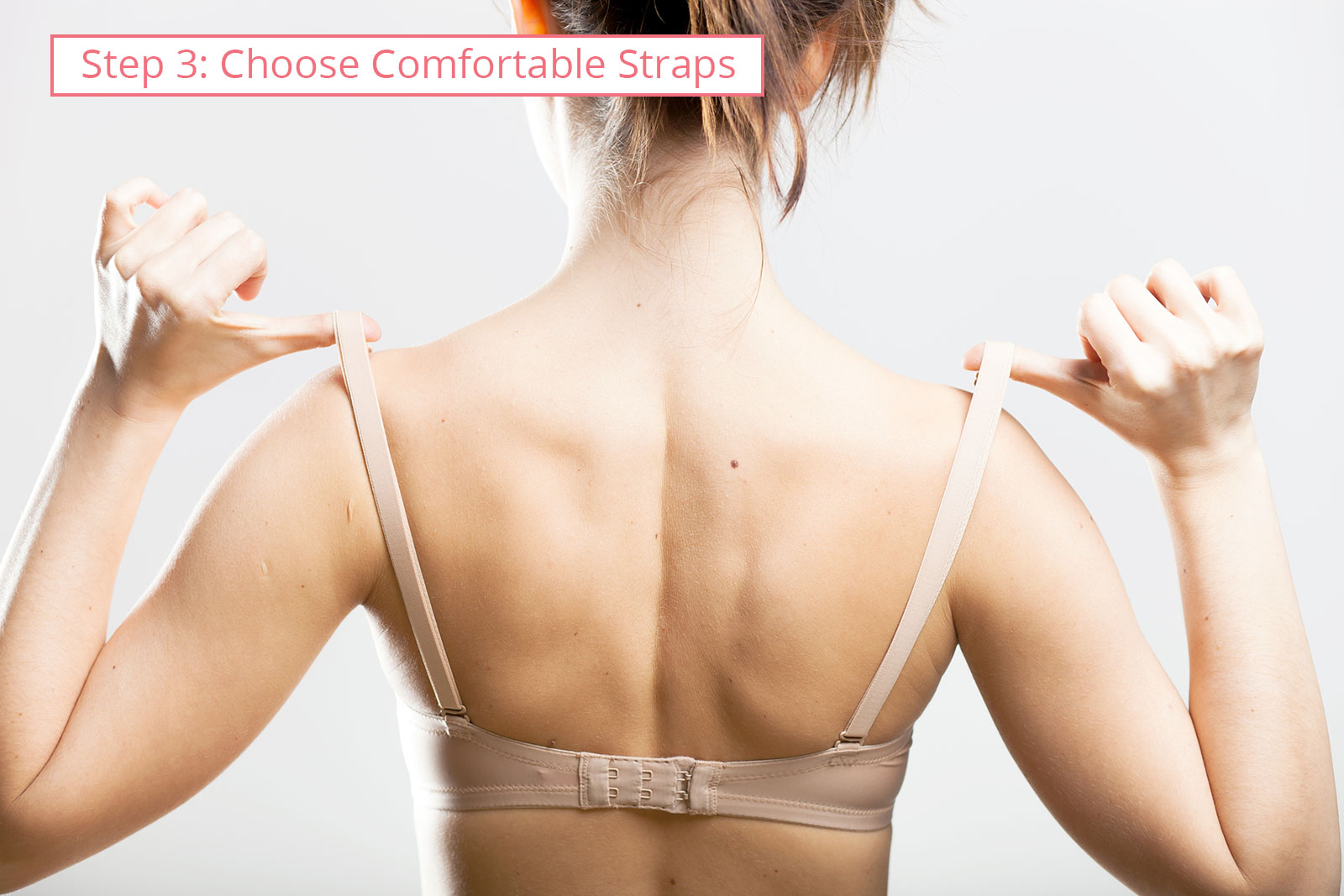
There are no strict requirements as per how to measure for a bra as far as straps are concerned, just keep in mind the following:
- The straps are only quarterbacks of the whole support process, the most work should be done by the band, otherwise you will experience shoulder pains and back discomforts;
- Move your arms freely – the straps should stay in place and not hinder your movements;
- When trying a bra for the first time, make sure the straps aren’t extended or shortened to the very last position, because it means that you won’t have possibility to adjust size later;
- If the bra has partially adjustable straps, make sure the comfortable position isn’t at the very end of the strap, since the fabric can loose its elasticity over time;
- If the straps are too loose – adjust them, but if they tend to fall down too often – maybe the cup isn’t full enough and you need to downsize;
- Constantly falling down straps mean that in this model they are set too far apart and this style is not meant for your shoulder types or that you need to go down in a band size for more support there;
- Be careful with the straps that are too thin – everyday models should have comfortable thick straps made of soft firm material.
Signs that you're wearing the wrong straps size:
- The shoulder straps dig in. This often means the band is too loose, forcing the straps to take the weight.
- The shoulder straps are constantly slipping off. This can be a sign that the band is too big, and therefore designed to fit a larger frame with broader shoulders. The shoulder straps on a smaller band size will be positioned closer together. If you find that you have to loosen the straps to prevent them from cutting in, this is also due to the band being too large and not supportive enough.
Let’s Sum up Everything in a Bra Sizes Chart?
So now that you know your most important measurements, let’s see again what size of bra you require. Of course there’s no rule that won’t allow you to go out of the size you’ve just defined, and for this reason you can benefit from the sister sizes chart above.
| Band Size | ||||||
|---|---|---|---|---|---|---|
| 30 | 32 | 34 | 36 | 38 | 40 | |
| Upper Bust | ||||||
| 24, 25, 26 | 26, 27, 28 | 28, 29, 30 | 30, 31, 32 | 32, 33, 34 | 34, 35, 36 | |
| Cup Size | Over Bust | |||||
| A | 29½ – 30¼ | 32¼ – 33 | 34¼ – 35 | 36¼ – 37 | 38¼ – 39 | 40¼ – 41 |
| B | 30¼ – 31 | 33 – 33¾ | 35 – 35¾ | 37 – 37¾ | 39 – 39¾ | 41 – 41¾ |
| C | 31 – 31¾ | 33¾ – 34¾ | 35¾ – 36¾ | 37¾ – 38¾ | 39¾ – 40¾ | 41¾ – 42¾ |
| D | 31¾ – 32¾ | 34¾ – 35½ | 36¾ – 37½ | 38¾ – 39½ | 40¾ – 42 | 42¾ – 44 |
| DD | 32¾ – 33½ | 35½ – 36¼ | 37½ – 38¼ | 39½ – 40¼ | 41½ – 42¼ | 43½ – 44¼ |
| DDD(E) | 33½ – 34¼ | 36¼ – 37 | 38¼ – 39 | 40¼ – 41 | 42¼ – 43 | 44¼ – 45 |
Once you’ve figured out how to measure your bra size in the brands you know and love, it will be easier for you to navigate their styles.
Mastering the fitting room magic
Okay, the math part is done, hurray! Who would have thought that such a little piece of clothing requires so much trouble defining the size, models and fits?
Now it’s time to try the model you’ve selected and see if it fits. Unfortunately many women encounter their first problem already in a fitting room, because they don’t know how to put on and wear a bra correctly. Here are the bra placement techniques you should follow daily, not just at the store:
- Begin in the front: take the bra by its band’s opposite ends and place the cups in front of your breasts;
- Lean a little forward to fit the bust into the cup, put the wires flat against the chest and hook the bra on the middle notch;
- Adjust and put the straps on;
- Adjust each breast in the cups. It’s OK to touch your bosom and manually put it in the right position inside the cup. To do this, first you need to secure the wire’s position with one hand and then spread the breast tissue away from the underarms area and towards the center;
- Now hold both wires with your hands and lean forward, do a little shaking to the left and right. When you rise back up the breasts will be positioned evenly inside the cup and pushed upwards a little.
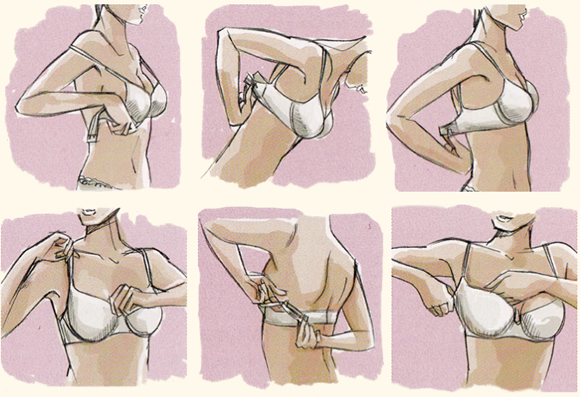
Double Check Your Bra Measurement
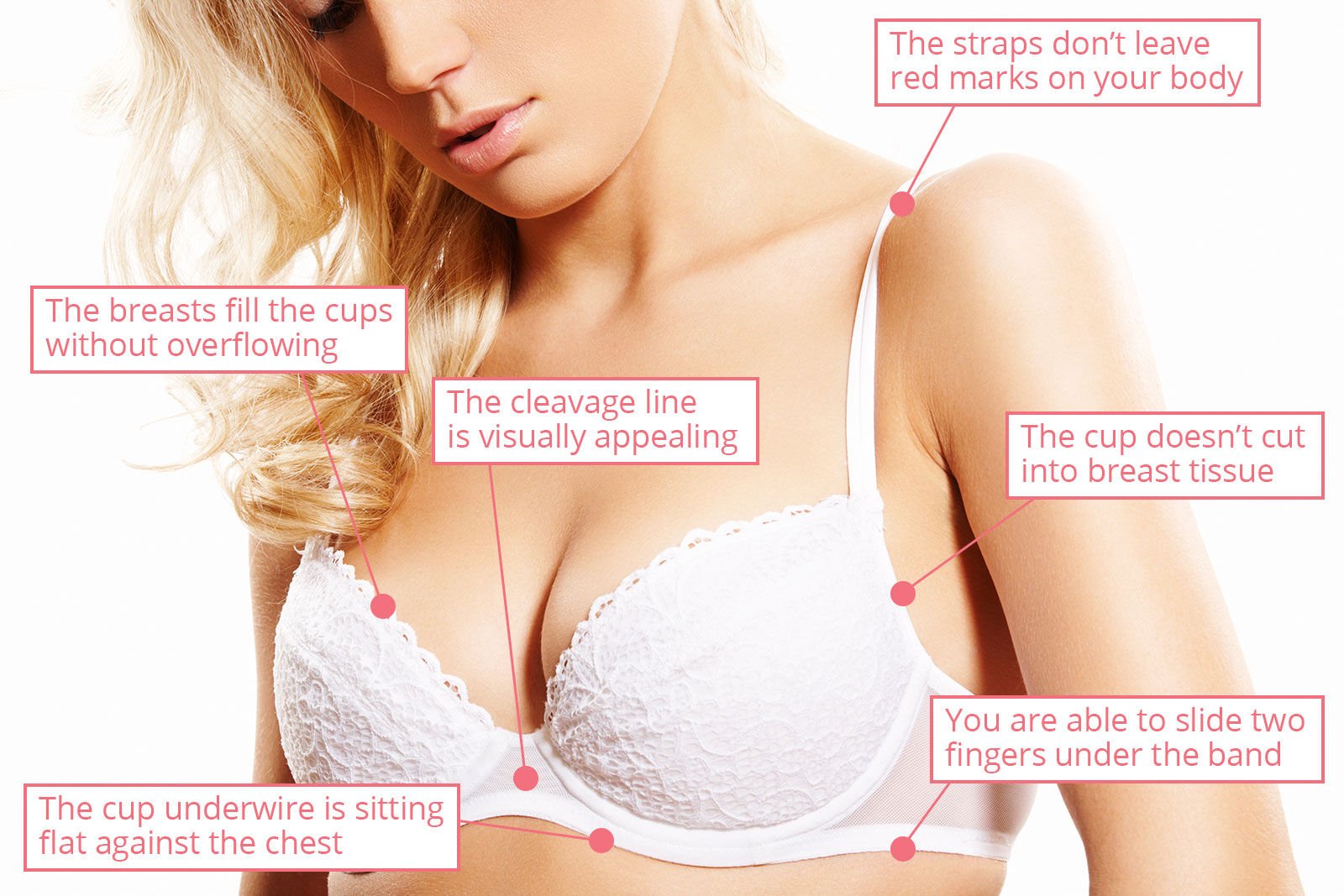
So you’ve chosen the right size and it fits just like you wanted? Congratulations, but don’t rush to the check out just yet. Let’s give yourself a second look and make sure this bra doesn’t just fit, but also looks good.
If you did everything right, your breasts mush have nice even shape and be positioned right in the middle between your shoulders and elbows. A little breast spillage is allowed for push-up or demi bras, all the other models should cover your bust evenly; the nipples should be facing front and center, the band and straps fit firmly against your skin without digging into it.
Double check that you look as good as you feel in this undergarment:
- The breasts fill the cups without overflowing
- The cup doesn’t cut into breast tissue
- The cup underwire is sitting flat against the chest
- You are able to slide two fingers under the band
- The straps don’t leave red marks on your body
- The cleavage line is visually appealing
Getting professionally fitted
If you decide to get a professional bra fitting, it's important that the fitter examines the way the bra actually fits, rather than simply using a tape measure. If you are measured and told your size straight away, then try somewhere else. The best fitters do not use a tape measure at all.
Fitting tips:
- When getting fitted for a bra, always go to a shop which stocks the full range of sizes. If you are smaller than a size 12, or if you have a larger than average bust for your size, bear in mind that you might need a size which is unavailable in most shops, and the shop assistant may give you a bra in the wrong size in order to make a sale (or they may not be aware that a better fitting bra exists.)
- Most people's breasts fluctuate in size, and they can sometimes grow for no apparent reason, so it's a good idea to review your size every six months or so.
- The correct band size is the smallest you can comfortably fasten around your back, and the right cup size is the biggest you can completely fill out with no wrinkles in the fabric.
- It's easier than you might think to wear the wrong cup size and not notice, and it's often only when you try on a bigger size that you realise the old size was too small. It's always a good idea to try on different cup sizes so you can actually compare.
- When trying on a new size, avoid heavily padded pushup bras if possible. It can be difficult to tell if they are meant to bulge out or if it's too small!
- A new bra should fit on the biggest adjustment to allow for the stretching that will occur as the bra starts to wear out. If it already fits comfortably on the smallest adjustment, go down a band size (and up a cup size to compensate.)
- If you have uneven cup sizes, go with the bigger side. You can help to support the smaller side by making that strap a bit shorter. If there is a difference of a whole cup size or more, you will probably need to pad out the smaller side with a cookie or chicken fillet. These are available at most lingerie shops.
- You may find it's better to buy a new bra when on your period or just before, you're often slightly bigger then. If your cup size changes a lot, don't try to squeeze into a bra that's too small - you may need to have different bras for these days.
- Always try on a bra before you buy, even if you think you know your size or you've bought that brand before.
- In a correctly fitting, supportive bra, your bustline will normally be around half way between your shoulder and your elbow, although your bust may be naturally positioned lower or higher on your chest.
- Don't forget to adjust the shoulder straps. They should be tight enough to stay on your shoulders, but they shouldn't dig in.
- If you find the bra lacks support unless you make the shoulder straps very tight, you probably need a smaller band size or a deeper, more supportive band.
- Check that the underwires are high enough at the sides to support most of the cup. Imagine a line connecting one end of the underwire to the other. The area under this line will be supported by the band, so if the centre of gravity of your breast is above this point, a large proportion of the weight will have to be taken by the straps. This is why plunge bras often seem to weigh down more on your shoulders, and why strapless bras are usually full cup styles.
Some oft-repeated bra myths:
- "The average bra size is a 36C." More bras are sold in 36C than any other size, but this does not make it the true average size by any means. Given that as many as 95% of women are wearing the wrong size bra, a survey of the bras we wear is almost useless in determining the average. Research by Bravissimo found that 60% of C cup wearers should be at least a D cup, and more than half of us are wearing a back size which is too big. The true average size is estimated to be around 34DD.
- "Most women are around a B-C cup. DD cups = huge. FF cups = fake." In fact, many women are a much bigger cup size than they think because wearing the wrong back size skews the cup size. The average size is around a DD, and a woman can easily be an E or even F cup without looking much bigger than average. People often forget, or are unaware, that cup size is relative - for example, a 28F would be roughly equal to a 36C in volume, and four cup sizes smaller than a 36F.
- "A 32 is small, a 38 is big." It's not as simple as that; the band size is only the size of the ribcage and bears no relation to the size of the breasts or the woman's body shape. Someone with a 32" band is just as likely to have DD cups (or even E, F, FF etc) as someone who wears a 38. This misconception may be due to the fact that many people incorrectly assume the number in the bra size is the bust measurement.
- "A pair of D-cup breasts weighs around 15 to 23 pounds." Anyone who understands how bra sizes work will see how ludicrous this claim is. Cup size alone is meaningless without the band size, so this does not give any indication of volume per se. In any case, this statistic gives a very distorted image of how big D cups are. In order to weigh this much, the band size would have to be very large indeed! One source [link] claims that a typical 36C breast (equivalent to a 34D) weighs 0.9kg which equates to just under a pound each - a much more realistic estimate!
- "No-one with a small band size has big boobs unless they're fake." As mentioned above, there is no reason why someone with a small band size cannot have a large cup size. People's idea of what constitutes a "normal" size often comes from the sizes available in the shops, so it is understandable that many people equate small band sizes with a flat chest, and large cup sizes with a fuller figure because it's often only the pre-teen bras which go smaller than a 32 band size, and only the plus size bras which go bigger than a DD cup.
- "The number of the bra size is the bust measurement." Another myth arising from the confusion of bra sizing. The number in the bra size is the band or back size, and refers to the size of your ribcage, not your bust. If your breasts grow, you need to go up a cup size, not a band size. You only need to get a bigger band size if the one you are wearing is too tight to fasten.
- "A band size 32 is the smallest you can get, so it must be around a size 8." Many people don't realise that band sizes actually start from 28, even in larger cup sizes. A band size of 32 is usually closer to a size 12, and if a woman has a large cup size, she could be wearing a size 14-16 and still need a 32" bra.
- "The bra should fasten on the smallest adjustment to allow you room to grow." There is little point in allowing room for growth, as your cup size is far more likely to change with weight gain than your band size. Bras will stretch with wear, so if it already fits you on the smallest adjustment, it will quickly become too big. The purpose of the adjustable back is to allow for this stretching.
- "To get your bra size, you have to add 4 to 5 inches to your underbust measurement, then work out your cup size based on your bust measurement. This is an accurate way of determining your size." Adding this much to your underbust measurement would mean your bra would ride up your back and offer hardly any support, especially if your breasts are heavy. If you are trying to get an idea of your bra size from your measurements, then you should just round your underbust measurement to the nearest even number. Quite apart from that, no formula will work for everyone so the right size is the one that fits!
- "Women with an underbust of less than 33 inches should add 4 or 5 inches to their measurement, and those with an underbust of 33 inches or more should add two to three inches." This is little more than a ploy to sell a narrow range of sizes to a wide range of consumers. It is possible to convince someone who needs a 28 band size that they will manage with a 32, but of course it would be impossible to fit someone who needs a 38 into a 34, thus the standard size range of 32-38 (just four different sizes!) is marketed to all. There is also an association between large band sizes and large cup sizes, so they are perceived as needing more support and thus a tighter band.
- "The shoulder straps support the breasts." Most of the weight of the breasts should be supported by the band around the chest, not the shoulder straps. The bra relies on the tension of this band to support the cups, and this is why it's so important that you wear the correct back size.
- "The size that the lady in the shop tells you is always the right one." While it is always a good idea to get fitted, it is also important to bear in mind that some fitters are better than others. A 2004 report by consumer watchdog Which? found that almost 80% of bra fittings resulted in a poor fit. Don't always take the fitter's word for it - try on a range of sizes to see for yourself and compare with the pointers in this guide. Many shops only stock the "average" sizes, so if you are quite slim and/or a large cup size, they may well put you in the smallest band size and largest cup size they have despite it still not fitting. For example, if you should be a 28F, they might put you in a 32DD. It is advisable to go to a shop which stocks a wide range of sizes. Bravissimo and Rigby & Peller are highly recommended for bra fitting.
- "If the shoulder straps dig in and your back hurts, it means you have very heavy breasts and there's not much you can do about it short of getting a breast reduction." If you are suffering pain because of a heavy bust, it's probably your bra, not you, that needs to change! NHS studies have found that as much as 100% of patients requesting breast reduction were wearing ill-fitting bras. [link] A better fitting bra will support from the chest and not dig into the shoulders as much, so there may not be any need to resort to surgery.
- "A certain amount of spillage is ok - that's what push-up bras are meant to look like anyway." Any amount of spillage in any type of bra means the cup size is too small. Even if you have cleavage, there should still be a smooth line at the edge with no "double boob" effect.
- "If your bra leaves red marks around your chest, it means the band size is too small." The truth is that any bra will leave some marks, even if it's quite comfortable. If the band is so loose that it leaves no mark on your skin at all, it's probably too big. Think about how many other types of clothing leave red marks and indentations on you - knicker elastic, the seams of your jeans, waistbands etc but nobody ever says that means they're too small!
- "The band is meant to be "comfy" and not too tight." The band of your bra is actually meant to be quite tight. Not so tight that it is painful, of course, but tight enough that it won't move around much.
- "If the back and sides of your bra make your flesh bulge, it's too tight." Bulges around the band of your bra are not necessarily a sign that you need a bigger band size. Wearing a smaller band size can actually reduce bulging, as it will be positioned lower on your back.
And finally – does the bra feel good wearing it? Then there’s no reason why you shouldn’t buy it. Browse here thousands of bra models from your favorite brands and compare them instantly to find the best fit!






